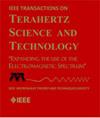研究具有不同拓扑结构的 CMOS 太赫兹探测器在 2.58 太赫兹频率下的性能提升情况
IF 3.9
2区 工程技术
Q2 ENGINEERING, ELECTRICAL & ELECTRONIC
IEEE Transactions on Terahertz Science and Technology
Pub Date : 2024-08-21
DOI:10.1109/TTHZ.2024.3447154
引用次数: 0
摘要
在这项研究中,我们设计了一款基于场效应晶体管的太赫兹(THz)检测器芯片,采用了标准的 55 纳米互补金属氧化物半导体工艺。该芯片包括八种不同的探测器结构,以探索各种因素对探测器性能的影响。每个检测器都有其独特的结构设计,表现出不同程度的寄生电容、端口阻抗匹配和不对称,所有这些都会影响检测器的响应度 (Rv)。在以前的非准静态模型的基础上,本研究通过结合等离子体波探测理论、天线阻抗、探测器的寄生效应、端口阻抗和负载效应,引入了一个全面的太赫兹探测器模型。我们还推导出了非谐振模式下 Rv 的数学表达式。与片上天线集成的多种不同结构的探测器在 2.58 太赫兹时实现了 437.6V/W 的最大 Rv 值和 119 pW/Hz1/2 的最小噪声等效功率 (NEP)。然后,我们对装有螺丝钉的纸质信封进行了扫描成像。螺丝钉的外观和信封上不同厚度的折痕细节清晰可见。分析表明,探测器的 Rv 和 NEP 与多个因素密切相关,包括天线和探测器之间的匹配、太赫兹波耦合点的寄生电容、耦合到探测器的太赫兹波能量的最大化、探测器的适当尺寸以及源极和漏极之间的不对称。本文章由计算机程序翻译,如有差异,请以英文原文为准。
Investigating Performance Enhancement of CMOS Terahertz Detectors With Different Topological Structures at 2.58 THz
In this study, we designed a terahertz (THz) detector chip based on field-effect transistors utilizing a standard 55-nm complementary metal–oxide–semiconductor process. The chip includes eight different detector structures to explore the impact of various factors on detector performance. Each detector, characterized by its unique structural design, exhibited varying levels of parasitic capacitance, port impedance matching, and asymmetry, all impacting the detector's responsivity (
Rv
). Building on the previous nonquasi-static model, this research introduced a comprehensive THz detector model by incorporating plasma wave detection theory, antenna impedance, parasitic effects of the detector, port impedance, and load effects. We also derived the mathematical expression for
Rv
in the nonresonant mode. The multiple different structures detectors integrated with antenna-on-chip achieved the maximum
Rv
of 437.6V/W and the minimum noise-equivalent power (NEP) of 119 pW/Hz
1/2
at 2.58 THz. We then conducted scanning imaging on a paper envelope containing a screw. The appearance of the screw and the details of creases at various thicknesses on the envelope were clearly visible. Analysis indicated that the detector's
Rv
and NEP are closely linked to several factors, including the match between the antenna and the detector, the parasitic capacitance at the THz wave coupling site, the maximization of THz wave energy coupled to the detector, the appropriate size of the detector, and the asymmetry between the source and drain.
求助全文
通过发布文献求助,成功后即可免费获取论文全文。
去求助
来源期刊

IEEE Transactions on Terahertz Science and Technology
ENGINEERING, ELECTRICAL & ELECTRONIC-OPTICS
CiteScore
7.10
自引率
9.40%
发文量
102
期刊介绍:
IEEE Transactions on Terahertz Science and Technology focuses on original research on Terahertz theory, techniques, and applications as they relate to components, devices, circuits, and systems involving the generation, transmission, and detection of Terahertz waves.
 求助内容:
求助内容: 应助结果提醒方式:
应助结果提醒方式:


